Ophthalmology
Early days
For almost 200 years Glasgow University has been recognised internationally as a Centre of Excellence for academic ophthalmology.
In 1824 Dr William Mackenzie (1791–1868) was co-founder, along with Dr GC Monteath, of a small Glasgow Eye Infirmary, near the Royal Infirmary at No 19, Inkle Factory Lane. In 1828, the University of Glasgow appointed Dr Mackenzie as the Waltonian Lecturer in Ophthalmology. In 1830, Mackenzie published the first textbook on Ophthalmology in the English language (A practical treatise on Diseases of the Eye) and it remained a key publication for several decades. In 1841, Mackenzie published a book on the Physiology of Vision that was regarded as ahead of its time.
The home of the Eye Infirmary moved to near the Royal Infirmary until 1874, when a new, purpose built facility was built on a site at the top of Berkeley Street and Sandyford Place. This comprised both a large outpatient facility and an inpatient hospital on Berkeley Street. Sadly this inpatient section was destroyed by fire in 1971 and the Department moved to Gartnavel General Hospital although the outpatient department remained in Sandyford Place for several years thereafter.
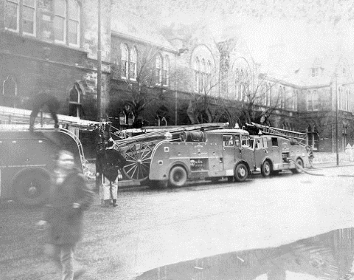
Dr Gavin P. Tennent (1846-1913), a successful physician in Glasgow, was aware that Ophthalmology was not limited to the study of eye disorders and their treatment, but had a wide application in the diagnosis and management of many incapacitating or life threatening systemic medical disorders that initially were detected in the eye or as a defect in vision. This recognition prompted him to donate £25,000 to Glasgow University (a large sum of money at the time) to create a Professorship in Ophthalmology.
His donation was invested and used to build the Tennent Memorial building, erected during 1933-35 at a cost of £45,000. The Tennent Memorial Building was situated at No 38 Church Street, at the Western Infirmary.
The Tennent Chair
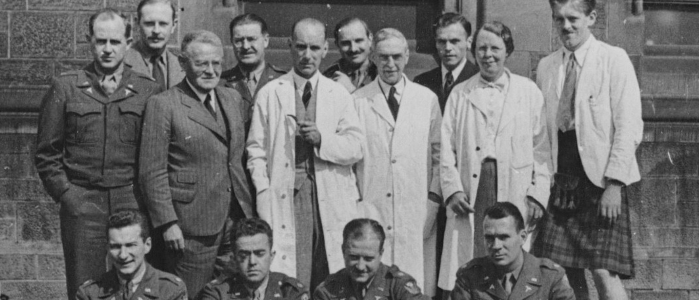
Professors Ballantyne and Riddell with staff outside the Tennent Institute, about May 1944
Back row, left to right – unknown civilian, US Army doctor, Professor Isaac Michaelson (in British Army uniform), unknown civilian, Dr WOG Taylor
Middle row – US Army doctor, Dr John Marshall (later chief at Glasgow Eye Infirmary), Professor Riddell, Professor Ballantyne, unknown doctor
Front row – four US Army doctors
The first appointee to the Tennent Chair in Ophthalmology (1935-1941) was Dr Arthur Ballantyne who occupied the first Chair in Ophthalmology in the United Kingdom.
His successor (1941-1964) was Dr William JB Riddell (1899-1977), who also served as Dean of the Faculty of Medicine. During the war, he investigated the harmful effects of chemical agents used in warfare, and later researched the heredity of eye and other medical disorders. His work on heredity resulted in the award in 1940 of the degree of MD with high commendation, and election to the Royal Society of Edinburgh.
In 1964, Dr Wallace S Foulds was appointed to the Tennent chair (1964-1989) having graduated MB ChB from Glasgow University in 1946 and subsequently trained in Ophthalmology in Moorfields Eye Hospital in London and as a Senior Registrar in University College Hospital London. He was then appointed a Consultant in Addenbrookes Hospital Cambridge where he held an honorary appointment as Lecturer in Cambridge University.
During this time he carried out research in the Institute of Ophthalmology of the University of London on closed angle glaucoma and retinal detachment, receiving the degree of MD with commendation for the former, and the degree of Master of Surgery with Honours for the latter, together with the award of the Mary Hawthorne Prize of the University of Glasgow.
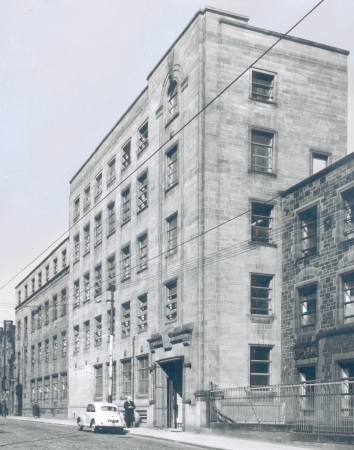
Following his appointment to the Tennent chair in 1964, the interior of the Tennent Memorial building was greatly modified to accommodate laboratories, space for scanning and transmission electron microscopes, as well as a lecture theatre for undergraduate and postgraduate teaching and for postgraduate courses designed to prepare overseas trainee ophthalmologists for Diploma and Fellowship examinations.
These courses were very popular and attracted postgraduate trainees from a wide variety of countries worldwide. Some 300 overseas postgraduates attended these courses.
Wallace Foulds
Professor Foulds fostered inter-disciplinary research, encouraging research workers funded from ophthalmic research grants to work in many basic science or clinical departments in the University of Glasgow and other Institutions for example, Departments of
- Pathology, Virology, Biochemistry, Anatomy and Cell Biology of the University of Glasgow
- Applied Chemistry & Pharmaceutical Sciences of Strathclyde University
- Chemistry of Paisley University (renamed the University of the West of Scotland)
- Optometry of the now Caledonian University
- University clinical departments such as the MRC Blood Pressure Unit at the Western Infirmary, Glasgow
- Biochemistry and Pediatric Neurology at the Royal Hospital for Sick Children in Glasgow
- Medicine at the Royal Infirmary in Glasgow
Department of Ophthalmology research publications in peer reviewed journals were greater per number of staff appointees than in almost every other University department.
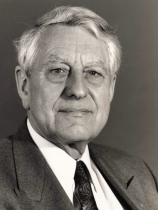
Professor Foulds chaired a Royal College of Ophthalmologists committee preparing an application to the Privy Council for a Royal Charter to establish a College of Ophthalmologists. The application was successful and Professor Foulds was the recipient of a Royal Charter for this purpose. He was the first and Founder President of the College, that later was granted a Home Office Licence that renamed it The Royal College of Ophthalmologists. He was awarded the CBE.
Research and Teaching
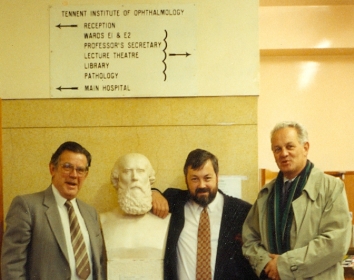
Ophthalmological research and teaching was greatly helped by the appointment of William R Lee, a pathologist, as a consultant in ophthalmic pathology. After training in General Pathology at the Western Infirmary, he was awarded a Fellowship to study in Boston (Massachusetts Eye and Ear) and Washington (Armed Forces Institute of Pathology).
In the University of Glasgow, he was awarded a personal chair in Ophthalmic Pathology, and in view of his internationally recognised research, was elected a Fellow of the Royal Society of Edinburgh.
His co-workers established scanning and transmission electronmicroscopy and immunoelectronmicroscopy, which provided the sources for postgraduate degrees. His textbook on Ocular Histopathology is now in a 3rd Edition. Professor Lee established an Ophthalmic Pathology Service for Scotland and parts of England. He was awarded a CBE in 1999.
Dr Jeffrey Jay, a Consultant Ophthalmologist to the Glasgow and West of Scotland NHS Trust was active in teaching undergraduates and postgraduates (both local and from overseas). He was a skilled surgeon and introduced to Glasgow new and innovative techniques in cataract surgery. He published clinical studies on the natural history and management of glaucoma, and diseases of the external eye. His experimental work included research into the applied physiology of vision and the adverse effects of intraocular solutions on the cornea which resulted in changes of the formulation to improve safety. He became President of the Royal College of Ophthalmologists and devised UK national programmes for cataract surgery and for diabetic retinopathy screening. He served on the GMC and was appointed CBE in 2001.
Professor Bertil Damato, Senior Lecturer, developed Professor Foulds’ invention of radical and innovative surgical treatment of malignant intraocular tumours, such as choroidal melanoma. He was appointed to the Chair of Ophthalmology in Liverpool to continue this work, and more recently to a Chair in Ocular Oncology in San Francisco. Professor John Forrester was appointed to the Chair in Aberdeen where he contributed to the understanding of chronic idiopathic inflammatory disease of the eye. Professor Ian Grierson, a protégé of Professor Lee, was appointed to Liverpool University; Professor Paul MacMenamin to Monash University, Melbourne; and Professor Charles McGhee to Auckland University. Drs David Keating and Stuart Parks, working in the NHS, expanded the development of both multifocal electro-retinography and ocular coherence tomography (OCT), and their seminal work on these techniques for analysing retinal function and visualising the interior of the eye are still widely cited.
Colin Kirkness (1948-2009) was appointed to the Tennent Chair (1990-2002), after a period when Professor Lee headed the University Department. His research was mainly directed at corneal disorders, including Botulinum toxin ptosis for corneal ulcer protection; chlorhexidine drops for management of acanthamoeba keratitis; and a safe surgical procedure for control of keratoglobus. He was Chairman of Examinations at the Royal College of Ophthalmologists, and President of the European Board of Ophthalmologists. The University Department of Ophthalmology, was closed in the reorganisation of clinical teaching which accompanied the introduction of the Problem Based Learning curriculum. Professor Kirkness died suddenly at home in Aberdeen not long after taking early retirement at the time of this reorganisation.
Paediatric Ophthalmology
Paediatric ophthalmology came to the fore in 1971 with construction of the new Children’s Hospital in Yorkhill, Glasgow. Dr Stanley Cant was appointed as the first consultant that year and worked with Dr Anna Kesson to set up this new service. Shortly thereafter, Dr John Dudgeon joined the team, academically focusing upon children’s retinal disorders, including retinoblastoma for which he provided a service for Scotland and Ireland.
Gordon Dutton succeeded Dr Cant in 1993, extending the paediatric electrophysiological services with the appointments of Drs Ruth Hamilton and Michael Bradnam, and setting up a combined paediatric visual and neuro-ophthalmological assessment service. During the 1990s and into the following decade, cerebral visual impairment became the leading cause of disordered vision in childhood in the industrialised world, and the Yorkhill Hospital team focused on this topic and contributed to the compilation of a series of publications and seminal textbooks on the subject. Dr Tim Lavy succeeded Dr Dudgeon, and was joined by Dr Jane McKinnon who developed clinical services further and made significant contributions to the academic literature.
Team working is essential in the context of paediatric ophthalmology, and in the 1990s Paediatric Community Physician Dr Linda de Caestecker was responsible for establishing city wide paediatric visual screening, with additional targeted visual screening for children with multiple disabilities.
Ophthalmic research in Glasgow continues in the Glasgow Centre for Ophthalmic Research, that was developed by Dr Stuart Parks, currently Head of Clinical Engineering in NHS Greater Glasgow and Clyde. He also leads the Medical Devices Unit at the Southern General Hospital in Glasgow which comprises a multidisciplinary team of mechanical/electronic/software engineers, technicians and scientists involved in the design, development and evaluation of novel technologies for medical research. The Unit not only develops new technologies but provides support for commercial and academic researchers from outside the NHS to evaluate devices that are likely to offer significant benefit to patients within the NHS.
Dr Parks has commercialised a number of medical devices. He has been the lead investigator in a broad range of research from device development and technology evaluation to clinical trials in areas as diverse as cancer, diabetes and epilepsy. As a Consultant Clinical Scientist, he also heads Vision Science within the Department of Clinical Physics and Bioengineering in Glasgow which has an international reputation in the development and innovation of new imaging modalities as well as providing a comprehensive national diagnostic imaging service for structural and functional imaging in Ophthalmology. The unit caters for over 8,000 patients per year from around Scotland.
Recently he established the Glasgow Centre for Ophthalmic Research to further enhance Glasgow's reputation as a leading centre in the development and investigation of technologies and treatments for eye disease that currently employs some 21 scientists.
As a dedicated NHS ophthalmic facility based at Gartnavel General Hospital, it houses a wide range of standard and specialised ophthalmic equipment within dedicated clinics. It consists of a multidisciplinary team including ophthalmologists, clinical research nurses, research scientists, technicians, coordinators and administrative staff with experience of commercial and non-commercial research. Although it was only established in 2012, it is now the largest ophthalmic research centre in Scotland and one of the largest in the UK. It is also a partner in the Commonwealth Eye Health Consortium. It is recognised at Scottish Governmental level and there are now ophthalmologists from other Health Boards working with the Centre. The Centre is in the process of developing a National Ophthalmic Research Innovative Cluster.
Professor Wallace S Foulds, Professor William Lee, Professor Gordon Dutton and Dr Jeffrey Jay.
Image for fire provided by Dr Marjorie Allison, others unless otherwise noted, by Professor Foulds and Dr Jay

